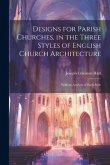A. Hamilton Thompson
The Ground Plan of the English Parish Church
A. Hamilton Thompson
The Ground Plan of the English Parish Church
- Broschiertes Buch
- Merkliste
- Auf die Merkliste
- Bewerten Bewerten
- Teilen
- Produkt teilen
- Produkterinnerung
- Produkterinnerung
This 1911 book was the first to devote itself entirely to the historical development and resultant features of the parish church in England.
Andere Kunden interessierten sich auch für
![The Ground Plan of the English Parish Church The Ground Plan of the English Parish Church]() A. Hamilton ThompsonThe Ground Plan of the English Parish Church22,99 €
A. Hamilton ThompsonThe Ground Plan of the English Parish Church22,99 €![A Short Description of Torre Abbey, Torquay, Devonshire, With Illustrations and Revised Ground Plan A Short Description of Torre Abbey, Torquay, Devonshire, With Illustrations and Revised Ground Plan]() Hugh Robert WatkinA Short Description of Torre Abbey, Torquay, Devonshire, With Illustrations and Revised Ground Plan18,99 €
Hugh Robert WatkinA Short Description of Torre Abbey, Torquay, Devonshire, With Illustrations and Revised Ground Plan18,99 €![St. Alban's Cathedral And Its Restoration ...: With A New Ground Plan And A Picture Of The Church In 1875 St. Alban's Cathedral And Its Restoration ...: With A New Ground Plan And A Picture Of The Church In 1875]() St. Alban's Cathedral And Its Restoration ...: With A New Ground Plan And A Picture Of The Church In 187517,99 €
St. Alban's Cathedral And Its Restoration ...: With A New Ground Plan And A Picture Of The Church In 187517,99 €![Fulham Old and New: Being an Exhaustive History of the Ancient Parish of Fulham: Fulham Old And New: Being An Exhaustive History Of The An Fulham Old and New: Being an Exhaustive History of the Ancient Parish of Fulham: Fulham Old And New: Being An Exhaustive History Of The An]() Charles James FèretFulham Old and New: Being an Exhaustive History of the Ancient Parish of Fulham: Fulham Old And New: Being An Exhaustive History Of The An27,99 €
Charles James FèretFulham Old and New: Being an Exhaustive History of the Ancient Parish of Fulham: Fulham Old And New: Being An Exhaustive History Of The An27,99 €![Designs for Parish Churches, in the Three Styles of English Church Architecture Designs for Parish Churches, in the Three Styles of English Church Architecture]() Joseph Coleman HartDesigns for Parish Churches, in the Three Styles of English Church Architecture24,99 €
Joseph Coleman HartDesigns for Parish Churches, in the Three Styles of English Church Architecture24,99 €![Fulham Old And New: Being An Exhaustive History Of The Ancient Parish Of Fulham; Volume 2 Fulham Old And New: Being An Exhaustive History Of The Ancient Parish Of Fulham; Volume 2]() Charles James FèretFulham Old And New: Being An Exhaustive History Of The Ancient Parish Of Fulham; Volume 227,99 €
Charles James FèretFulham Old And New: Being An Exhaustive History Of The Ancient Parish Of Fulham; Volume 227,99 €![Fulham Old and New: Being an Exhaustive History of the Ancient Parish of Fulham; Volume 3 Fulham Old and New: Being an Exhaustive History of the Ancient Parish of Fulham; Volume 3]() Charles James FèretFulham Old and New: Being an Exhaustive History of the Ancient Parish of Fulham; Volume 329,99 €
Charles James FèretFulham Old and New: Being an Exhaustive History of the Ancient Parish of Fulham; Volume 329,99 €-
-
-
This 1911 book was the first to devote itself entirely to the historical development and resultant features of the parish church in England.
Hinweis: Dieser Artikel kann nur an eine deutsche Lieferadresse ausgeliefert werden.
Hinweis: Dieser Artikel kann nur an eine deutsche Lieferadresse ausgeliefert werden.
Produktdetails
- Produktdetails
- Verlag: Cambridge University Press
- Seitenzahl: 152
- Erscheinungstermin: 10. Mai 2011
- Englisch
- Abmessung: 203mm x 127mm x 8mm
- Gewicht: 171g
- ISBN-13: 9781107401600
- ISBN-10: 1107401607
- Artikelnr.: 32946805
- Herstellerkennzeichnung
- Libri GmbH
- Europaallee 1
- 36244 Bad Hersfeld
- gpsr@libri.de
- Verlag: Cambridge University Press
- Seitenzahl: 152
- Erscheinungstermin: 10. Mai 2011
- Englisch
- Abmessung: 203mm x 127mm x 8mm
- Gewicht: 171g
- ISBN-13: 9781107401600
- ISBN-10: 1107401607
- Artikelnr.: 32946805
- Herstellerkennzeichnung
- Libri GmbH
- Europaallee 1
- 36244 Bad Hersfeld
- gpsr@libri.de
Preface
Part I. The Origin of the Church Plan in England: 1. The basilican church plan
2. Problem of its derivation
3. Rival theories of its origin
4. The Roman basilica: old St Peter's
5. Basilicas at Ravenna
6. Tomb-churches and baptisteries
7. Centralised plans at Ravenna
8. Relative advantages of the basilican and the centralised plan
9. The basilican church at Silchester
10. Early churches in Kent and Essex
11. Bradford-on-Avon, Wilts
12. Escomb church, Durham
13. Early Northumbrian churches
14. Wilfrid's churches at Hexam and Ripon
15. Brixworth, Northants: other basilican plans
16. Brixworth, Northants: other basilican plans
17. Exceptional occurrence of the basilican plan in England
Part II. Parish Churches of the Later Saxon Period: 18. The normal pre-Conquest plan
19. The western bell-tower
20. Plans in which the ground floor of the tower forms the body of the church
21. Barton-on-Humber and the centralised plan
22. Centralised planning in England
23. The Saxon lateral porch
24. Development of the transeptal chapel
25. Towers between nave and chancel
26. Development of the cruciform plan
27. Development of the cruciform plan
28. Influence of local material upon the aisleless church plan
Part III. The Aisleless Church of the Norman Period: 29. Survival and development of the aisleless plan after the Conquest
30. The nave of the aisleless church
31. Rectangular chancels
32. Churches with no structural division between nave and chancel
33. Churches with apsidal chancels
34. The quire
35. The transeptal chapel
36. Cruciform plan: North Newbald and Melbourne
37. Later developments of the cruciform plan
38. Symbolism in planning
Part IV. The Aisled Parish Church
Section 1. Nave, Tower, and Porches: 39. Survival of the aisleless plan
40. The addition of aisles
41. The use of aisles for side altars
42. Twelfth century aisled plans
43. Ordinary method of adding aisles
47. Raunds church, Northants
48. Conservative feeling of the builders for old work
49. Aisles widened and rebuilt
50. Rebuilding of aisles as chantry chapels: Harringworth, Northants
51. Newark, Cirencester, Northleach, and Grantham
52. Naves lengthened westward
53. The western tower in relation of the plan
54. Engaged Western towers, etc.
55. Rebuilding of towers
56. Porches
57. Position of the porch in the plan
Part V. The Aisled Parish Church
Section 2. Transepts and Chancel: 58. Cruciform churches with aisled transepts
59. Addition of transeptal chapels
60. Variety of treatment of transeptal chapels
61. Transeptal chapels as a key to original ground plans
62. Incomplete cruciform plans
63. Irregular cruciform plans
64. Central towers with transeptal chapels
65. Transeptal towers
66. Lengthening of chancels
67. Encroachment of the chancel on the nave: Tansor
68. Chancel chapels
69. Churches with one chancel chapel
70. Chantry chapels attached to chancels
71. Effect of the addition of chapels on the cruciform plan
72. The aisled rectangular plan
73. Variations on the plan with aisled nave and chancel
74. Development of the aisled rectangle at Grantham
75. Deviation of the axis of the chancel
Index of places.
Part I. The Origin of the Church Plan in England: 1. The basilican church plan
2. Problem of its derivation
3. Rival theories of its origin
4. The Roman basilica: old St Peter's
5. Basilicas at Ravenna
6. Tomb-churches and baptisteries
7. Centralised plans at Ravenna
8. Relative advantages of the basilican and the centralised plan
9. The basilican church at Silchester
10. Early churches in Kent and Essex
11. Bradford-on-Avon, Wilts
12. Escomb church, Durham
13. Early Northumbrian churches
14. Wilfrid's churches at Hexam and Ripon
15. Brixworth, Northants: other basilican plans
16. Brixworth, Northants: other basilican plans
17. Exceptional occurrence of the basilican plan in England
Part II. Parish Churches of the Later Saxon Period: 18. The normal pre-Conquest plan
19. The western bell-tower
20. Plans in which the ground floor of the tower forms the body of the church
21. Barton-on-Humber and the centralised plan
22. Centralised planning in England
23. The Saxon lateral porch
24. Development of the transeptal chapel
25. Towers between nave and chancel
26. Development of the cruciform plan
27. Development of the cruciform plan
28. Influence of local material upon the aisleless church plan
Part III. The Aisleless Church of the Norman Period: 29. Survival and development of the aisleless plan after the Conquest
30. The nave of the aisleless church
31. Rectangular chancels
32. Churches with no structural division between nave and chancel
33. Churches with apsidal chancels
34. The quire
35. The transeptal chapel
36. Cruciform plan: North Newbald and Melbourne
37. Later developments of the cruciform plan
38. Symbolism in planning
Part IV. The Aisled Parish Church
Section 1. Nave, Tower, and Porches: 39. Survival of the aisleless plan
40. The addition of aisles
41. The use of aisles for side altars
42. Twelfth century aisled plans
43. Ordinary method of adding aisles
47. Raunds church, Northants
48. Conservative feeling of the builders for old work
49. Aisles widened and rebuilt
50. Rebuilding of aisles as chantry chapels: Harringworth, Northants
51. Newark, Cirencester, Northleach, and Grantham
52. Naves lengthened westward
53. The western tower in relation of the plan
54. Engaged Western towers, etc.
55. Rebuilding of towers
56. Porches
57. Position of the porch in the plan
Part V. The Aisled Parish Church
Section 2. Transepts and Chancel: 58. Cruciform churches with aisled transepts
59. Addition of transeptal chapels
60. Variety of treatment of transeptal chapels
61. Transeptal chapels as a key to original ground plans
62. Incomplete cruciform plans
63. Irregular cruciform plans
64. Central towers with transeptal chapels
65. Transeptal towers
66. Lengthening of chancels
67. Encroachment of the chancel on the nave: Tansor
68. Chancel chapels
69. Churches with one chancel chapel
70. Chantry chapels attached to chancels
71. Effect of the addition of chapels on the cruciform plan
72. The aisled rectangular plan
73. Variations on the plan with aisled nave and chancel
74. Development of the aisled rectangle at Grantham
75. Deviation of the axis of the chancel
Index of places.
Preface
Part I. The Origin of the Church Plan in England: 1. The basilican church plan
2. Problem of its derivation
3. Rival theories of its origin
4. The Roman basilica: old St Peter's
5. Basilicas at Ravenna
6. Tomb-churches and baptisteries
7. Centralised plans at Ravenna
8. Relative advantages of the basilican and the centralised plan
9. The basilican church at Silchester
10. Early churches in Kent and Essex
11. Bradford-on-Avon, Wilts
12. Escomb church, Durham
13. Early Northumbrian churches
14. Wilfrid's churches at Hexam and Ripon
15. Brixworth, Northants: other basilican plans
16. Brixworth, Northants: other basilican plans
17. Exceptional occurrence of the basilican plan in England
Part II. Parish Churches of the Later Saxon Period: 18. The normal pre-Conquest plan
19. The western bell-tower
20. Plans in which the ground floor of the tower forms the body of the church
21. Barton-on-Humber and the centralised plan
22. Centralised planning in England
23. The Saxon lateral porch
24. Development of the transeptal chapel
25. Towers between nave and chancel
26. Development of the cruciform plan
27. Development of the cruciform plan
28. Influence of local material upon the aisleless church plan
Part III. The Aisleless Church of the Norman Period: 29. Survival and development of the aisleless plan after the Conquest
30. The nave of the aisleless church
31. Rectangular chancels
32. Churches with no structural division between nave and chancel
33. Churches with apsidal chancels
34. The quire
35. The transeptal chapel
36. Cruciform plan: North Newbald and Melbourne
37. Later developments of the cruciform plan
38. Symbolism in planning
Part IV. The Aisled Parish Church
Section 1. Nave, Tower, and Porches: 39. Survival of the aisleless plan
40. The addition of aisles
41. The use of aisles for side altars
42. Twelfth century aisled plans
43. Ordinary method of adding aisles
47. Raunds church, Northants
48. Conservative feeling of the builders for old work
49. Aisles widened and rebuilt
50. Rebuilding of aisles as chantry chapels: Harringworth, Northants
51. Newark, Cirencester, Northleach, and Grantham
52. Naves lengthened westward
53. The western tower in relation of the plan
54. Engaged Western towers, etc.
55. Rebuilding of towers
56. Porches
57. Position of the porch in the plan
Part V. The Aisled Parish Church
Section 2. Transepts and Chancel: 58. Cruciform churches with aisled transepts
59. Addition of transeptal chapels
60. Variety of treatment of transeptal chapels
61. Transeptal chapels as a key to original ground plans
62. Incomplete cruciform plans
63. Irregular cruciform plans
64. Central towers with transeptal chapels
65. Transeptal towers
66. Lengthening of chancels
67. Encroachment of the chancel on the nave: Tansor
68. Chancel chapels
69. Churches with one chancel chapel
70. Chantry chapels attached to chancels
71. Effect of the addition of chapels on the cruciform plan
72. The aisled rectangular plan
73. Variations on the plan with aisled nave and chancel
74. Development of the aisled rectangle at Grantham
75. Deviation of the axis of the chancel
Index of places.
Part I. The Origin of the Church Plan in England: 1. The basilican church plan
2. Problem of its derivation
3. Rival theories of its origin
4. The Roman basilica: old St Peter's
5. Basilicas at Ravenna
6. Tomb-churches and baptisteries
7. Centralised plans at Ravenna
8. Relative advantages of the basilican and the centralised plan
9. The basilican church at Silchester
10. Early churches in Kent and Essex
11. Bradford-on-Avon, Wilts
12. Escomb church, Durham
13. Early Northumbrian churches
14. Wilfrid's churches at Hexam and Ripon
15. Brixworth, Northants: other basilican plans
16. Brixworth, Northants: other basilican plans
17. Exceptional occurrence of the basilican plan in England
Part II. Parish Churches of the Later Saxon Period: 18. The normal pre-Conquest plan
19. The western bell-tower
20. Plans in which the ground floor of the tower forms the body of the church
21. Barton-on-Humber and the centralised plan
22. Centralised planning in England
23. The Saxon lateral porch
24. Development of the transeptal chapel
25. Towers between nave and chancel
26. Development of the cruciform plan
27. Development of the cruciform plan
28. Influence of local material upon the aisleless church plan
Part III. The Aisleless Church of the Norman Period: 29. Survival and development of the aisleless plan after the Conquest
30. The nave of the aisleless church
31. Rectangular chancels
32. Churches with no structural division between nave and chancel
33. Churches with apsidal chancels
34. The quire
35. The transeptal chapel
36. Cruciform plan: North Newbald and Melbourne
37. Later developments of the cruciform plan
38. Symbolism in planning
Part IV. The Aisled Parish Church
Section 1. Nave, Tower, and Porches: 39. Survival of the aisleless plan
40. The addition of aisles
41. The use of aisles for side altars
42. Twelfth century aisled plans
43. Ordinary method of adding aisles
47. Raunds church, Northants
48. Conservative feeling of the builders for old work
49. Aisles widened and rebuilt
50. Rebuilding of aisles as chantry chapels: Harringworth, Northants
51. Newark, Cirencester, Northleach, and Grantham
52. Naves lengthened westward
53. The western tower in relation of the plan
54. Engaged Western towers, etc.
55. Rebuilding of towers
56. Porches
57. Position of the porch in the plan
Part V. The Aisled Parish Church
Section 2. Transepts and Chancel: 58. Cruciform churches with aisled transepts
59. Addition of transeptal chapels
60. Variety of treatment of transeptal chapels
61. Transeptal chapels as a key to original ground plans
62. Incomplete cruciform plans
63. Irregular cruciform plans
64. Central towers with transeptal chapels
65. Transeptal towers
66. Lengthening of chancels
67. Encroachment of the chancel on the nave: Tansor
68. Chancel chapels
69. Churches with one chancel chapel
70. Chantry chapels attached to chancels
71. Effect of the addition of chapels on the cruciform plan
72. The aisled rectangular plan
73. Variations on the plan with aisled nave and chancel
74. Development of the aisled rectangle at Grantham
75. Deviation of the axis of the chancel
Index of places.








